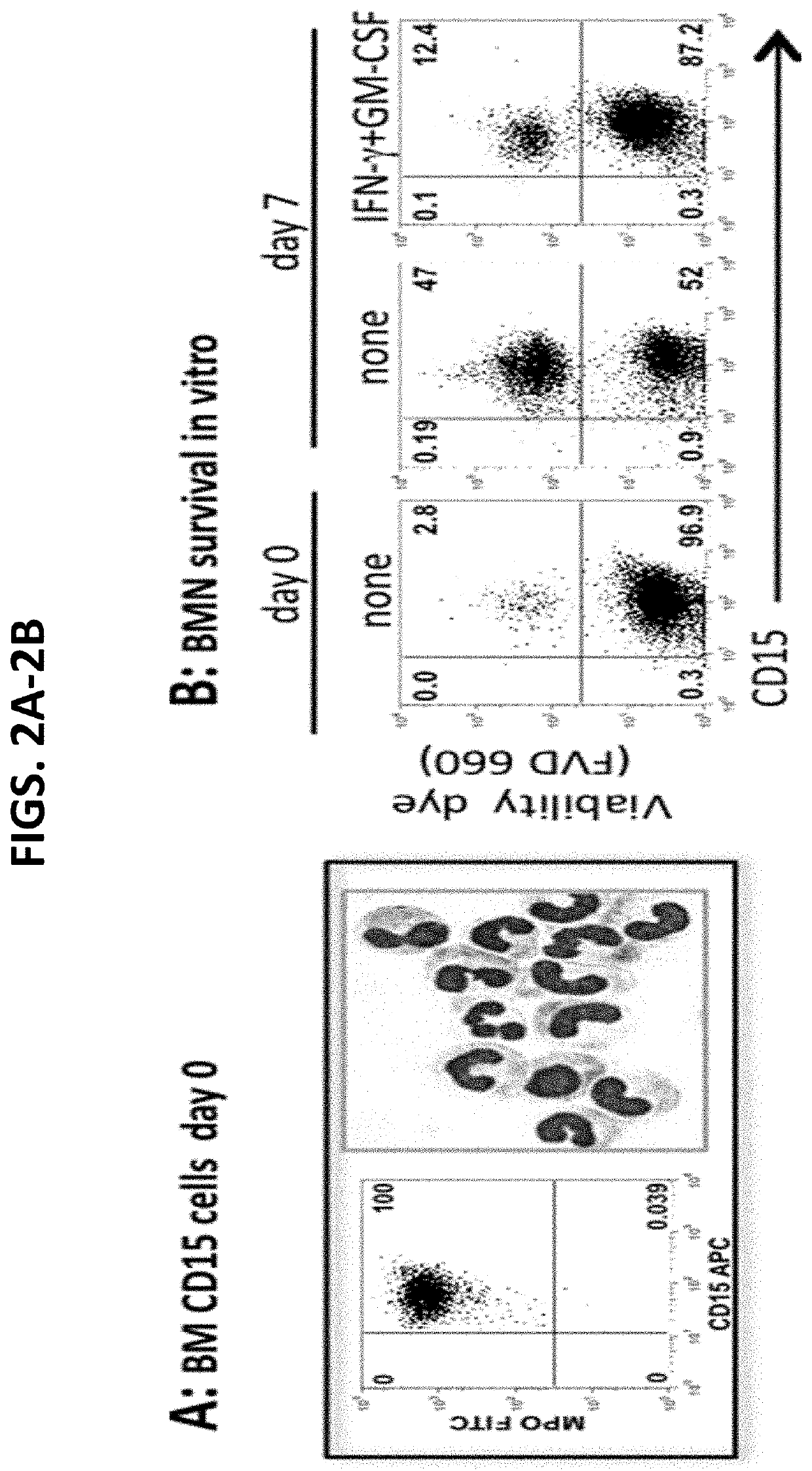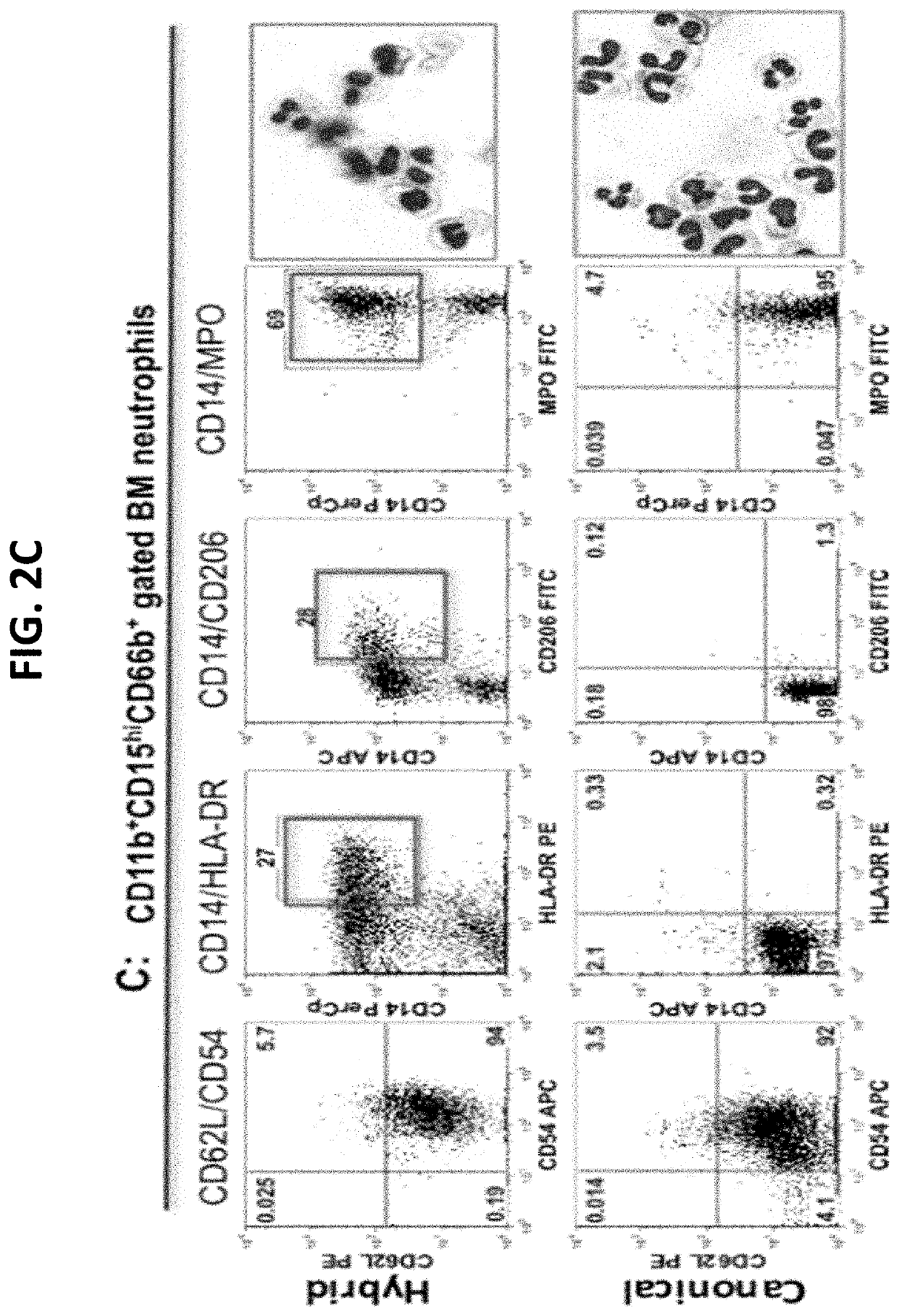Compositions and methods of enhancing Anti-tumor response using hybrid neutrophils
a technology of hybrid neutrophils and anti-tumor cells, which is applied in the field of compositions and methods of enhancing anti-tumor responses using hybrid neutrophils, can solve the problems of poor clinical efficacy of many therapeutic antibodies, limited therapeutic effects in trials, and the need for improvement of neutrophil-mediated ab therapy
- Summary
- Abstract
- Description
- Claims
- Application Information
AI Technical Summary
Benefits of technology
Problems solved by technology
Method used
Image
Examples
example 1
ation of a Novel Subset of Tumor-Associated Neutrophils (TANs) Exhibiting the Composite Characteristics of Neutrophils and Antigen-Presenting Cells
[0203]Characterization of tumor-associated neutrophils (TANs) revealed that the majority of TANs in early stage of non-small cell lung cancer (NSCLC) express classic neutrophil markers CD11b+CD15hiCD66b+MPO+Arg1+(“canonical TANs”, FIG. 1B, boxes in lower left corner). However, another subpopulation of TANs that displayed a combination of neutrophil (Arg1+MPO+CD66b+CD15+) and antigen-presenting cell (APC) (CD14+HLA-DR+CCR7+CD86+) markers was identified. This subpopulation of TANs is hereinafter referred to as “hybrid TANs” or “hybrid tumor-associated neutrophils.” (FIG. 1B, boxes in upper right corner). The frequency of these newly identified “hybrid” subset of TANs varied widely in tumor tissues of cancer patients (FIG. 1C).
example 2
ation of Conditions in which the Immature Bone Marrow or Peripheral Blood Granulocytes could be Differentiated into Hybrid Neutrophils in a Large Numbers
[0204]Using anti-CD15 magnetic beads, a highly enriched population of human bone marrow neutrophils (BMNs) was obtained from rib fragments that were removed from patients during routine lung cancer surgery. It was found that these BMNs exhibited a prolonged survival in vitro compared to peripheral blood neutrophils (PBNs). These CD15+BMNs expressed the myeloid / granulocytic specific markers CD11b, CD66b, Arg1, myeloperoxidase (MPO) and were mostly “band”-like immature neutrophils (FIG. 2A; FIG. 2C). Importantly, unlike blood, about 40% of these BMNs could survive in cell culture for up to 1 week (FIG. 2B). Thus, human BMNs have a prolonged lifespan in vitro, providing large quantities of cells (>50 million cells) that can be used to differentiate immature neutrophils into the hybrid neutrophils.
[0205]Several ways to differentiate imm...
example 4
utrophils Trigger and Stimulate Effector T Cell Responses
[0213]Results of the studies described herein demonstrate that tumor or BM-derived hybrid neutrophils were able to: (1) dramatically augment proliferation of naïve resting T cells stimulated with anti-CD3 / CD28 Abs compared to canonical neutrophils (FIG. 6A; FIGS. 6E-6H); (2) augment response of anti-tumoral effector T cells (FIG. 6B; FIGS. 6I-6L); (3) present viral antigens to autologous memory CD8 and CD4 cells (FIG. 6C); and, (4) cross present tumor antigens to cytotoxic T cells (FIG. 6D; FIG. 6M). Given these findings, it is expected that the expansion and use of hybrid neutrophils in humans can significantly augment the efficacy of therapeutic antibodies and boost anti-tumor and anti-infectious immunity.
PUM
| Property | Measurement | Unit |
|---|---|---|
| concentrations | aaaaa | aaaaa |
| concentration | aaaaa | aaaaa |
| concentration | aaaaa | aaaaa |
Abstract
Description
Claims
Application Information
 Login to View More
Login to View More - R&D
- Intellectual Property
- Life Sciences
- Materials
- Tech Scout
- Unparalleled Data Quality
- Higher Quality Content
- 60% Fewer Hallucinations
Browse by: Latest US Patents, China's latest patents, Technical Efficacy Thesaurus, Application Domain, Technology Topic, Popular Technical Reports.
© 2025 PatSnap. All rights reserved.Legal|Privacy policy|Modern Slavery Act Transparency Statement|Sitemap|About US| Contact US: help@patsnap.com



